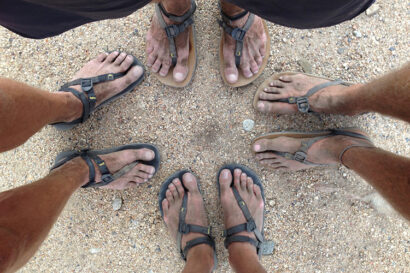Forager, runner, election auditor: This expert seeks answers on the trail
For Philip Stark, trail running — often in sandals, sometimes for 100 miles at a time — is the playground and laboratory where his greatest ideas and interests are born
July 5, 2023
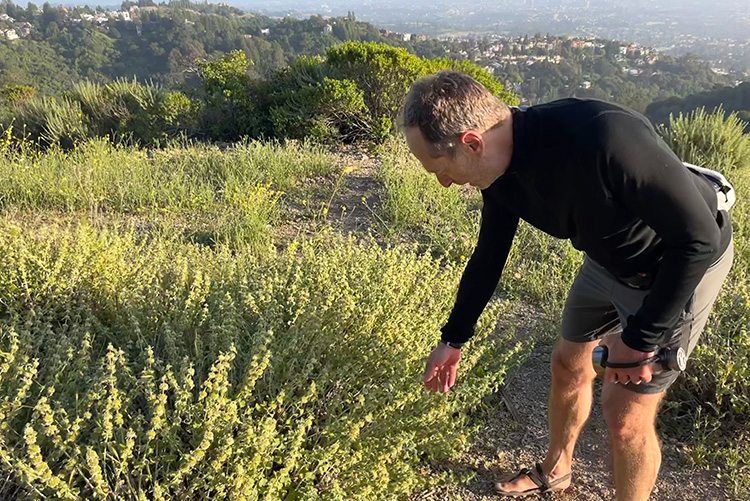
Philip Stark, a statistics professor at UC Berkeley, is a man of varied interests. From expertise on election auditing to encyclopedic recall about edible plants, trail running has long linked his pursuits and his passion for spreading that knowledge. “Given that I’ve got the attention,” Stark said, “I’ll try to use it for something of value.” (UC Berkeley photo by Jason Pohl)
Philip Stark isn’t easily defined.
There’s Stark, the UC Berkeley statistician, whose pragmatic mind sees problems and finds solutions in ways few can match. There’s Stark, the election security expert who’s risen to national prominence for his efforts to ensure election integrity. And there’s Stark, the admittedly eccentric forager, on a mission to educate the masses about the nutritious plants in their own backyards.
What links his specialties is not just a 35-year career at UC Berkeley. For Stark, trail running — often in sandals, sometimes for 100 miles at a time — is the playground and laboratory where his greatest ideas and interests are born.
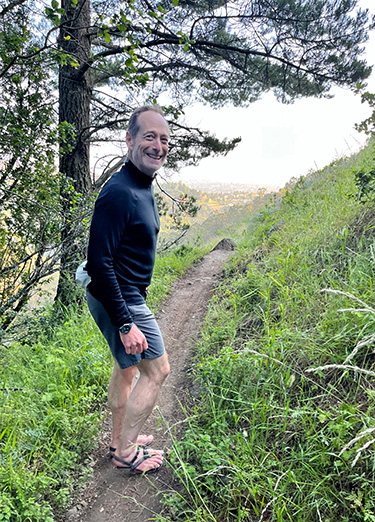
Stark often takes evening trail runs to contemplate work and, mostly, to forage wild plants for dinner. (UC Berkeley photo by Jason Pohl)
Stark as trail runner was the role that most appealed to me as I began working on his profile. So, as an ultrarunner myself, and an ultramarathon coach, I suggested I join him on a run.
He granted my unusual request to learn the basics of foraging. But during our two-hour sunset jaunt through the Berkeley hills above campus, I learned as much about Stark’s fascination with edible plants as I did of his love of trail running.
Stark also revealed on the trail how he was targeted by right-wing conspiracy theories after the 2020 presidential election, his views on race and privilege, and how his life was changed by a nearly fatal spinal infection.
For these past 25 years, he told me, trail running has been a means to meditate on it all.
It’s a sport that’s saved him and — despite distances many consider absurd — keeps him sane.
Reflecting on privilege and peculiarity
We’d only run 15 seconds when Stark stopped, eagerly pointing out purple dead nettle, miner’s lettuce and forget-me-nots. A particularly rainy year had caused the entire hillside along Panoramic Way to flourish.
“This is a salad bar!” he exclaimed.
Within no time, Stark was handing me leaves and flower petals to nibble. I politely started chewing, not allowing myself to think whether it was safe to eat unwashed plant parts handed to me by a man I’d only just met. This, I reasoned, would be my modus operandi for the next couple of hours. A few strides later, we marveled at a strawberry tree. Stark plucked a red fruit for me, saying they’re plentiful on campus, a bounty to be had, and “good for jam.”
I was hardly the first writer to take Stark’s tour of edible flora. In 2014, Berkeley News wrote about his efforts to teach people in food deserts how to identify nutritious plants in their neighborhoods. Food journalist Mark Bittman walked and nibbled with him for a piece in The New York Times. Bon Appetit featured him, too, in a story headlined, “There’s Probably a Salad’s Worth of Greens On Your City Block.”
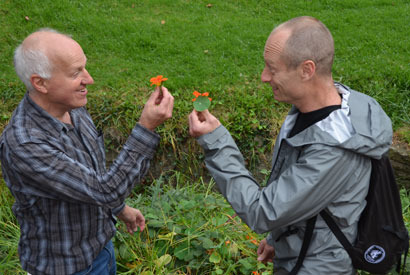
Tom Carlson (left) and Stark with edible nasturtiums near the Valley Life Sciences Building in a photo for a 2014 profile on their foraging work. (Photo by Hulda Nelson)
The themes of those and subsequent pieces were often the same: What was urban foraging? Was it safe? And why is a quirky statistician from Berkeley doing it?
As much as I wanted to learn about the plants I could harvest for myself on trail runs and backpacking trips, I also wanted to understand the collector and the array of interests that motivate one of Berkeley’s most brilliant scholars.
As we ran up a steep climb, I asked Stark what he made of the media attention he’s received: “What does it feel like to have the spotlight on your perceived strangeness?”
“I’m in a very entitled position in this world,” he told me. “I am white, male and of European ancestry. I’m educated and have a job at one of the world’s best universities. All of those things give me a podium that a lot of people don’t get.
“I try to use that for good.”
From philosophy to geophysics
Stark’s path to Berkeley was anything but ordinary. He uses the term idiosyncratic.
He dropped out of high school in 1976 to attend MIT, where he planned to major in physics and philosophy. After a year, however, he transferred to Princeton and focused on philosophy. His next adventure? Law school at the University of Texas at Austin. He dropped out after six weeks.
After a stint at a marketing firm, Stark returned to academia, first taking pre-med courses, then starting graduate work in geophysics. He transferred to UC San Diego’s Scripps Institution of Oceanography to work with luminaries in geophysical inverse theory, which studies the interior of the earth by remote sensing using mechanical vibrations (seismology), electricity and magnetism, much like MRIs are used to study the interior of the human body.
Moonlighting as a self-employed car mechanic, Stark finished his Ph.D. in geophysics using supercomputers to analyze seismic data to study the structure of Earth’s core. After a brief postdoctoral position at UCSD, he came to the Berkeley statistics department as a postdoc in 1987. In 1988, he joined the statistics faculty, embracing probability and statistics research and broadening his wide range of specialties.
We slowed to a hike on a particularly steep fire road to talk about the salad potential of dandelions, the refreshing scent of pineapple weed and the “outsized” credit Stark continues to receive for his foraging know-how. Indigenous cultures, for thousands of years, have used many plants we were stopping to nosh for food, medicine and spiritual practices.
“Do I have pangs of guilt about it? Yes,” he said. “There are other people who are more deserving of the attention than I am. But given that I’ve got the attention, I’ll try to use it for something of value.”
“As an educator,” he added, “if I could feed people by giving them some information, how great is that?”
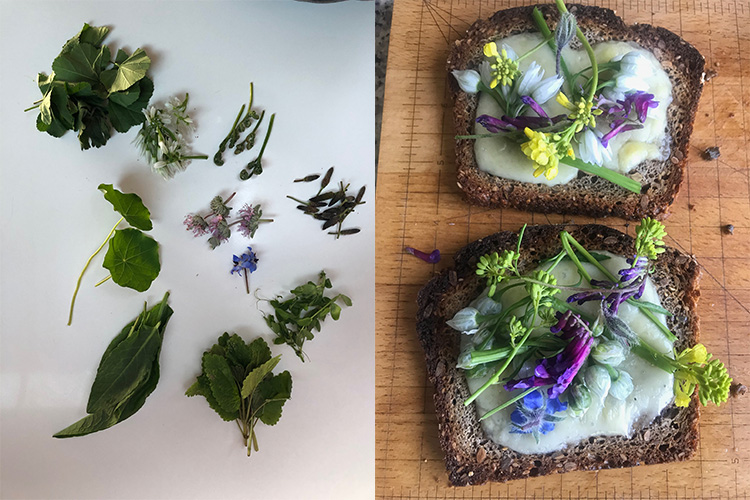
Stark uses foraged greens to accent multiple meals each week. (Photos courtesy Philip Stark)
A mission to make foraging mainstream
Foraging is unlawful in most public places in the U.S. (Midway through our run, Stark recommended that I not take photos of us picking plants, just in case.) Yet, it’s a seldom-enforced policy and one Stark has tried unsuccessfully to change. He co-wrote a white paper about foraging’s benefits, hoping it would spark conversation. Essentially, he said, knowing how to identify and pick fresh greens helps individuals and communities reconnect with nature and add some green nutrients to their diets. It encourages them to be custodians of nature and provides healthful physical activity. It’s why he and others have published field guides to East Bay plants and launched the Berkeley Open Source Food project.
But some jurisdictions cite liability as the reason they can’t condone foraging — a laughable rationale, Stark said, since parks allow people to race mountain bikes along rocky ridges at their own risk.
Foraging rules don’t dissuade Stark. Especially not while logging miles on sunset runs, stuffing his bounty into the pockets of his running shorts.
To limit his effects on the landscape, Stark seeks out abundant non-native, invasive plants, including plants that public agencies often try to control with chemical herbicides, mowing machines or ravenous goats. His harvest list is long. Invasive Mediterranean short-pod mustard? Add the fresh leaves to salads, blanch them to make ohitashi, or use the flowers as a garnish. Sowthistle stems? Cook them like asparagus. English plantain seed pods? Fried in butter, they taste like morels. Bracken Ferns? Pickle them, and you won’t be disappointed.
Within a couple of miles, Stark has highlighted more than 20 different edible plants for me, and I’ve sampled a dozen. I only wanted to spit out one, Brassica nigra, a black mustard whose delayed punch to the senses stuck with me for the next mile.
In his defense, Stark warned me that one was “loud in the mouth.”
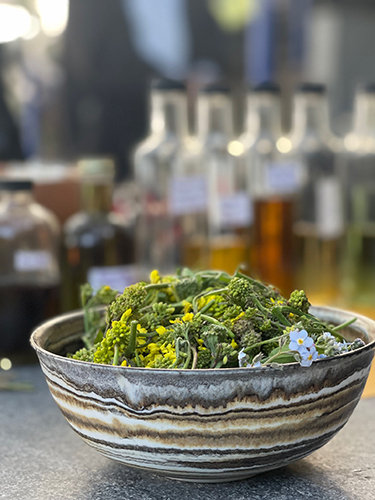
Stark tries to bring home enough foraged plants to accent — or completely build — a foraged salad. (Photo courtesy Philip Stark)
“Knowing how to feed yourself is probably the most basic thing every human being ought to know how to do,” Stark said. “And yet, we as a species don’t train our kids to recognize food in the environment, which is truly, truly astonishing to me.
“We don’t know in our culture whether something is food or not unless somebody gives it to us on a plate or it’s on the grocery store shelf in plastic.”
We turned off the wide trail and onto a barely detectable single-track path lined with poison oak — one of the few plants I could readily identify before this run. Tiptoeing our way along, I asked him what started all of this.
That’s when we started talking about trail running.
Origin of foraging
In the 1990s, trail running was largely a misfit sport among dirtbaggers eager to push the limits of human endurance. It was also an excuse to hang out outside and, often, avoid some uncomfortable reality. For Stark, who’d been a professor at Berkeley for a decade, it was a crumbling personal relationship. He hated running, but needed an escape.
So he turned to the trails.
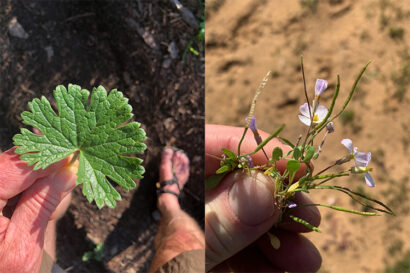
Checkerbloom (left) and wild radish are two of the many plants Stark forages in Berkeley. (Photos courtesy Philip Stark)
It was on those ever-increasing runs that he began to notice how the plants along the trail changed with the seasons. “What’s that flower?” he’d wonder. Then he questioned his own interest in that kind of trivia.
“Why do I care what it’s called?” he remembered pondering. “That’s this funny Western notion of naming something as somehow being important knowledge.”
Then, he added, came the real question: What’s it good for?
So he made a list of edible plants to identify. That evolved into plucking and stuffing plants in his pockets when running. Soon, it became a game of trying to forage something new on every trail run.
Next, he challenged himself to find a new species each week.
“We really are wired to recognize this stuff,” he said. “We are hunter-gatherers by evolution. You start to see it everywhere.”
One day, on a long run near Tilden Park, Stark saw something else: the Dick Collins Firetrails 50 Mile race. His jaw dropped when he learned that some of these runners pushing their bodies for hours upon hours were only there to qualify for the race they really wanted to run, an event in Auburn called the Western States 100-mile Endurance Run.
He was hooked, he said, and had found his crowd. Soon, he was lining up for 50-and 100-mile events himself. And at that point in his life, all was well.
But while all runners have injury-laden seasons due to stress fractures or muscle strains, Stark’s life in 2006 took a dangerous, life-altering turn.
Bedridden in Berkeley; chasing antelope in Wyoming
That October, Stark ran the Dick Collins Firetrails 50.
By January 2007, he was bedridden, hooked up to an IV and unsure he’d walk again.
Doctors think a routine dental cleaning dislodged bacteria that entered his bloodstream, traveled to his lower spine and infected the disc and two vertebrae.
“I went from someone who was running 100 miles to being completely dependent on other people,” Stark said, tempering his horrifying story by pointing to Ithuriel’s spear and blue dicks, native perennial herbs growing vibrantly on the hillside.
Stark spent four-and-a-half months helpless and in excruciating pain. Then, when he’d recovered enough to leave his bed and begin moving, he relied on his fascination with biomechanics and human development to try and heal himself.
“I worked my way back to walking by crawling on all fours,” he said.
It wasn’t pretty, he admitted. But day by day, he regained strength. As a joke, he registered for that same October race again, doubting he’d even make it to the start line.
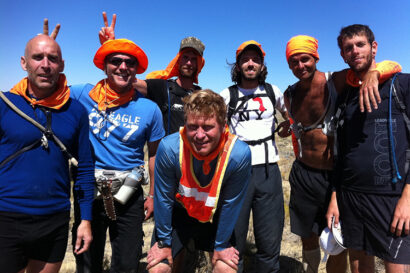
Stark took this photo of his friends during a “persistence hunt” in the Red Desert of Wyoming in 2011. Left to right, back row: “Barefoot Ted” McDonald, Dennis Shaver, Scott Smuin, “Caveman” John Durant, Patrick Sweeney, Bookis Smuin. Front: Ulrich Honighausen. (Photo courtesy Philip Stark)
But to his surprise, he finished the race only 15 minutes slower than he had the year before. It showed how resilient humans can be. The body, not gear and technology, could yield strength.
With this epiphany, Stark embraced minimalist running and a more Spartan lifestyle. To get around, he began walking, running or riding a bicycle that folds down to the size of a carry-on bag. He also started running barefoot and in sandals, like the ones he wore on our evening run as we ducked and weaved around a fallen tree.
Stark asked if I’d read Born to Run, the international bestseller by Christopher McDougall that chronicles the long-distance running Tarahumara tribe in Mexico and radically changed the sport of running — or at least the way people talked about it. The book highlights the ways humans are evolutionarily designed to run and the purported benefits of going barefoot.
The book features Barefoot Ted McDonald, a legend in the sport who runs long distances shoeless. And there’s Micah True, also known as Caballo Blanco, the late ultrarunner who pioneered the race in Mexico. And also Ann Trason, called “la bruja” (the witch) in the book, the holder of a vast number of ultrarunning course records.
“Those are my friends,” Stark said, casually.
Back in the day, he continued, True parked his truck in front of Stark’s home during a multi-month trip. Stark, Barefoot Ted, and two other friends co-founded the adventure sandal company Luna.
And in 2011, after Stark’s 50th birthday, they joined famed runner Patrick Sweeney in an attempt to chase down an antelope in the Red Desert of Wyoming. Sweeney was the fastest and led the chase — Stark said he had embraced a more gingerly cadence since his spinal cord infection made his lower back bones look and feel like “garbage.”
The antelope lost them after about 6 miles.
Undeterred, they concocted a new plan: pursue a mule deer in the Eastern Sierra.
They didn’t see a single one.
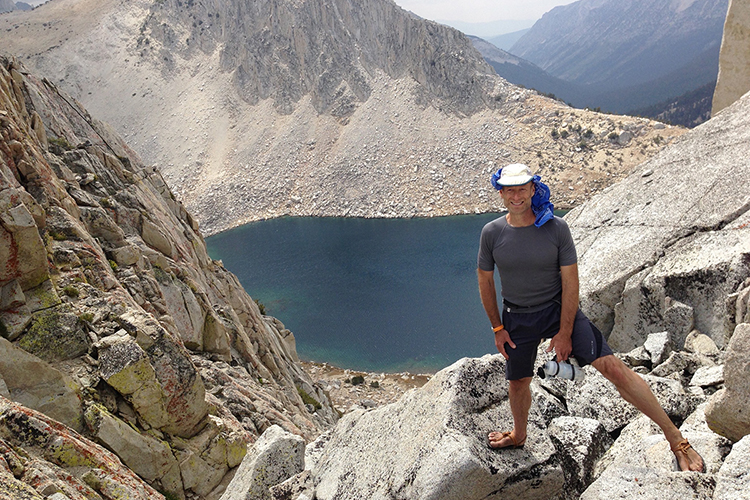
Stark and friends made a second attempt at a persistence hunt in the Eastern Sierra near Bishop, California, in 2013. (Photo courtesy Philip Stark)
Building the future of election integrity
As Stark and I trotted toward Chaparral Peak, the sun filtering through the pines and shoulder-high thistles — pokey, but edible — I was starting to see how running was Stark’s constant amid life’s chaos. It brought him into the world of foraging. It introduced him to wacky characters who are legends of the sport. It opened trails where he ponders and puzzles through his lot in life and questions that fascinate him academically.
By this point, I’d sampled nearly 25 of Stark’s preferred edible plants and knew I’d never look at my surroundings the same.
But Stark had more to introduce me to on the trail: his dealings with election denialism, insurrection attempts and online harassment.
There are other people who are more deserving of the attention than I am. But given that I’ve got the attention, I’ll try to use it for something of value.
– Philip Stark
Between Stark’s illness and his subsistence hunt, the California Secretary of State in 2007 tapped his statistical wizardry to help review how election results are audited in California and other states, and whether audits could address cybersecurity vulnerabilities of voting equipment. This was a decade before conspiratorial claims of “rigged elections” ran rampant. It would prove prescient.
Historically, election audits involved some scrutiny of the vote counts, but they didn’t accomplish anything in particular, and it perplexed Stark.
While out for a run one day, Stark realized election officials and the state working group he was on should stop focusing on how frequently errors — like an improperly filled-in oval on a ballot — occurred. Instead, how could an audit be conducted so that the auditors and the public are highly confident that the reported winners really won?
A new process called a risk-limiting audit was born.

Philip Stark (left) and Ron Rivest conduct a risk-limiting election audit in Napa, CA. (Photo by Cyrus Farivar)
Essentially, Stark proposed auditing by manually reading the votes from an expanding random sample of trustworthy, hand-marked paper ballots. The audit is halted if and when the sample gives sufficiently strong evidence that a total hand count would be pointless and that the reported winners really won. If the audit doesn’t find strong evidence, it expands to a complete hand count, which sets the record straight.
The “risk” limited by a risk-limiting audit is the chance that a wrong outcome will become final, rather than be corrected by the audit. When the reported outcome is wrong, a risk-limiting audit is intended to become a full hand count; when the outcome is right, a risk-limiting audit is intended to do as little work as possible.
Local and state election officials embraced the new methods, as did the National Academies of Sciences, Engineering, and Medicine. He helped draft legislation and worked with success to build trust with election officials across the country. Fifteen U.S. states require or authorize risk-limiting audits, which have also been piloted in Denmark.
“I’m a thing in that community,” he said, nonchalantly.
Folded ballots, dusty machines and far-right threats
Still foraging, I learned to distinguish chickweed, a great salad addition, from scarlet pimpernel, which can be lethal. I also learned from Stark about auditing election results from a 2020 contest in New Hampshire that stirred conspiracy theories peddled by Donald Trump and his supporters.
It’s a bit of a long story, Stark warned me. The short version is that a recount of a New Hampshire state representative contest that year found about 300 additional votes for each of the four winning candidates in a vote-for-four contest, all Republicans, while the runner-up Democrat on the ballot lost about 100 votes in the recount. The recount didn’t change who won, but some voters considered it proof that the election had been rigged to favor Democrats. Trump echoed those claims, and New Hampshire was quickly swept up in claims of fraud, not unlike claims about the presidential election in Arizona, Georgia and Michigan.
It was a year of a lot more care.
– Philip Stark
Stark was tapped to join a three-person auditing team that led a systematic and closely watched review of the voting machines and ballots. With in-person observers and cameras streaming 24/7, they devised systems to explain the discrepancy. In the end, they found that a letter-folding machine routinely used to mail out DMV renewals had been repurposed to fold absentee ballots to meet the unprecedented high demand due to the pandemic.
The letter folder had inadvertently — but frequently — creased the ballots through the oval for the runner-up Democratic candidate, instead of folding along the pre-scored line. The scanners interpreted many of the folds as marked ovals. Dust from the ballots had also accumulated on the scanner lenses, exacerbating the problem. It was a “conspiracy of coincidences,” as one auditor called it — not a deep-state cabal — that had affected the vote tallies.
But some people claimed Democrats had rigged the machines, and that the auditors, including Stark, gave those crooked officials cover when they got caught.
Self-declared “patriots” showed up at the former home of one of the auditors, Stark said.
Some advocated online to “bring out the gallows.”
After that, Stark took steps to purge much of his public presence from the internet.
“It was a year of a lot more care,” Stark said, referring to the increased vigilance and concern for his safety. “And now, some of these people from New Hampshire are surfacing again.”

Stark is passionate about helping others see the value in foraging. “We really are wired to recognize this stuff,” he said. “We are hunter-gatherers by evolution. You start to see it everywhere.” (UC Berkeley photo by Jason Pohl)
Exploring passions while foraging plant parts
As Stark and I neared his front porch and the end of our run, I was exhausted — less from physical exertion and more from all my mind had taken in about this prominent campus statistician and renowned election security expert who co-owns an adventure sandal company, patented a special sandal lacing system and eats foraged plants.
I caught myself thinking about the importance of one’s varied interests and how that fosters a balanced life. About eclectic passions. About how we often only scratch the surface of the people we meet. And about how my own love of trail running has helped me to break down barriers and solve problems over the years.
Then Stark, still hyper alert, pointed out, likely for the third time, the English Plantain growing along the roadside. To my surprise, I recalled it immediately, along with his sage advice: Collect the unopened seed pods and toss them in a skillet. Everything’s tastier with butter.

